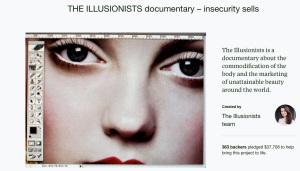A couple years ago, I came across Elena Rossini’s Kickstarter campaign for a film titled “The Illusionists”. The film received sufficient backing and has been created over the past two or three years. Last week, Elena Rossini made the film available to backers and soon it will distributed more widely.
The film is comprised of historic juxtaposition images and film-clips that demonstrate not only the sexualisation of the female body in advertising and film but also the emergence of a standardised, global body image. This is most clearly and dramatically shown in the examination of the Japanese pop-group AKB 48.
Rossini uses AKB 48 as prototype for what we can expect if the recent development of the global media, celebrity and advertising continues in the same strides it has over the past few decades. Some bodies will disappear as Susie Orbach, who is interviewed in the film, says, and the Western image of the body that pervades media representation all over the world, will displace other representations of the body. And as the film powerfully shows by referring to the beauty products and their sales figures media representations increasingly have in impact on people’s actual body image and the work they conduct in order to shape their body to simulate the body of the media.
The content of the film also links nicely to current academic discussions about beauty and aesthetic judgement. Whilst in the past aesthetics was often considered as a category dealt with mainly in the arts more recently there has been considerable discussion about “practical aesthetics“, musical aesthetics, and everyday talk about beauty, aesthetics and fashion. The film neatly complements these discussions and the ways in which images of beauty and the sense of beauty change over time. Following Elena Rossini it seems that these changes are often driven by the ways in which bodies are represented in popular culture, including advertising, magazines and film. Further research on the relationship between body images, popular culture and celebrity culture might be interesting to pursue.

